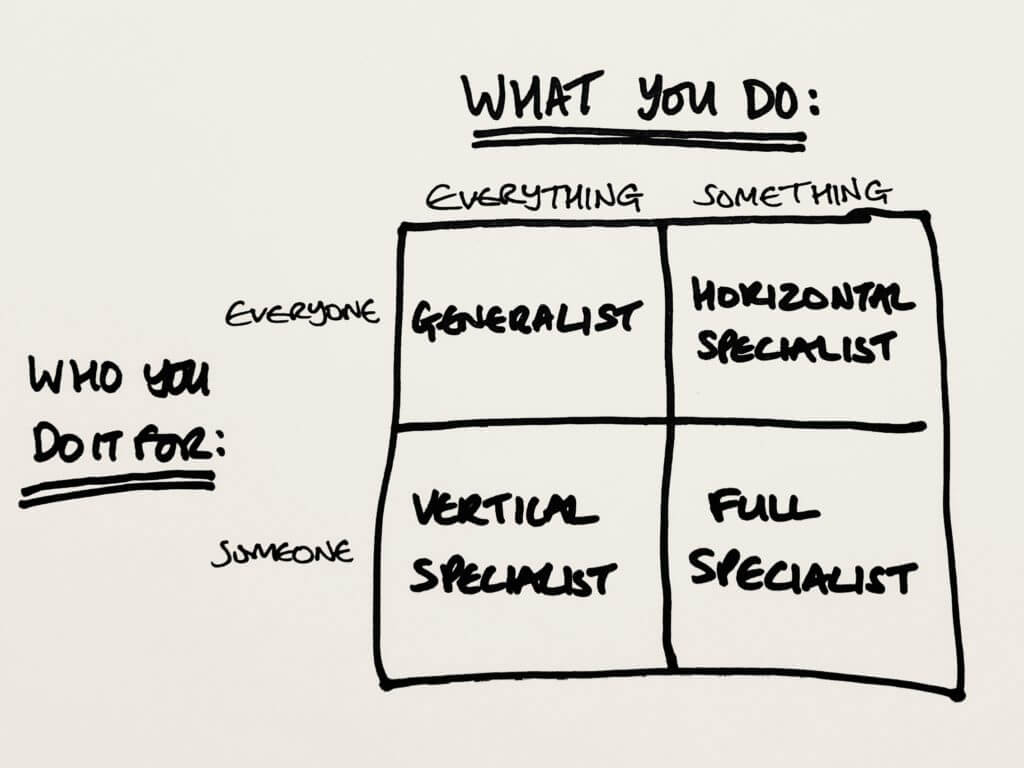Becoming more focused is beneficial for your agency transformation, but narrow application of words like ‘niche’ and ‘specialise’ can cause all sorts of trouble.

The Bee Gees sang ‘It’s only words. And words are all I have’. Despite their wonky grammar, when it comes to the importance of words, the brothers Gibb were spot-on.
They were almost certainly singing about the modern malaise of agencies saying much the same thing using much the same words.
Hence so many Founders and CEOs looking to stand out by specialising. But why is this transition so tricky?
The answer is words – the language of specialisation is too loaded and too simple.
The problem with ’niche’
Suggesting ‘niche’ to an agency chief often elicits wide eyes, raised eyebrows, and – one assumes – clenched buttocks. But ‘niche’ means ‘small’, they protest; that’s not the road to riches.
They also tend to overestimate the sacrifice needed to ‘specialise’, assuming they’d have to bin half their clients and – worse – half their team.
So why the knee-jerk terror?
What specialisation means
The specialisation debate is usually based on a fairly obvious Boston matrix:

The four quadrants are:
- Generalist: selling a range of services to everyone – often ‘integrated’ or ‘full-service’ agencies
- Vertical specialist: selling a range of services into a single sector
- Horizontal specialist: selling a single discipline to everyone
- Full specialist: selling a single discipline into a single sector.
First of all, none of these are wrong. And despite the success of plenty of generalists – many of whom, it has to be said, succeed in spite of their generalism – let’s accept the implied hierarchy that the more specialised you are, the better.
But – and it’s a big but (and I cannot lie) – there’s a world of nuance that gets lost in the language. I’ll come back to that.
For now, let’s look at the three types of specialist.
In praise of vertical positioning
Vertical positioning is offering a range of services to a discrete audience, i.e. every-thing for some-one. It’s usually defined by industry sector – like finance, healthcare or travel. Think Digital Dialog or DDB Health.
Happily, vertical audiences are easy to reach via dedicated media, awards, trade shows etc. They often use specific jargon too, so you can ‘show them you know them’ with your industry language.
Vertical specialists can be highly prized; making better margins and being easier for your clients to take with them as they change jobs within their sector. Your specialism helps them avoid being seen to be hiring their mates.
Despite all this, most agencies don’t position themselves vertically. It feels boring or limiting. They make the same argument against in-housing – looking at the same problems every day surely kills innovation and repels talent.
So what about horizontal positioning?
Let’s get horizontal, baby
This is about offering one thing to a broad audience. It’s where most agencies end up – discipline specialists open to any client, like Sunday (content marketing) or every ad agency in the universe.
Clearly the variety is attractive and you’re less likely to come unstuck if the bottom falls out of your specific market sector.
Better still if you’re a leader in an emerging discipline. Imagine being into web design in the 90s, social media in the 2000s or service design since 2010. Ch-ching! Ditto these days for specialists in, say, developing Alexa Skills.
On the flipside, you lose the vertical benefits. For one, it’s harder to command a premium. And without a readymade audience and deep sector-specific knowledge, demonstrating expertise to new clients relies even more on thought leadership.
No wonder horizontally aligned (and generalist) agencies are so quick to shout about their ‘sector experience’. But really, you’re damning yourself with faint praise. It’s not a differentiator; it’s barely table stakes. You’re better off trading on your fresh eyes, objectivity or the applicability of proven thinking from another sector.
Best of both worlds
The final quadrant combines vertical and horizontal, i.e. a specific discipline for a single sector, like Editions Financial or Taste PR.
Surely this is the best of both worlds? Maybe.
On the face of it, combining the benefits makes a lot of sense – especially if you’re unknown, so your depth of knowledge mitigates your lack of badge value. Knowing their sector and a discipline can also make clients more forgiving of conflict.
But the risk here is going too deep. There may well be a gap in the market, but is there a market in the gap?
Perhaps you’re a Magento expert for greetings card companies. Even if that’s in real demand, what happens when you’ve re-platformed them all?
It takes courage to focus, but don’t be reckless.
Why positioning is still a headache
So, four options – you pay your money and take your choice, right?
Well, no.
All this theory is fine. But if it’s as easy as deciding on either or both vertical and horizontal, then why do so many agencies waste years trying to resolve the question?
As mentioned, it’s because we’re glossing over a tonne of nuance.
Most obviously, the boundaries between ‘horizontal’ agency disciplines are getting blurrier every day. Also, a vertical sector, like the greetings card example, can be big or small. So targeting ‘B2B’ vs. ‘dry cleaners in Staines’ is a completely different business model.
In fact, ‘vertical’ doesn’t even have to mean ‘sector’. It might be company size, age, culture, mindset, geography, budget or anything. It’s better to think ‘audience’ rather than ‘industry’.
Similarly, ‘horizontal’ doesn’t have to be an agency discipline. You could address a specific use case or problem, like inertia, a competitive threat or operating in regulated markets. So focus less on services and more on outcome and proposition.
Most importantly, broadening your definitions of vertical and horizontal mean they’re no longer mutually exclusive. For instance, ‘companies that need international growth’ is both an audience and a problem to solve.
Likewise, does helping clients target a 50+ audience make Older vertically positioned for those companies or horizontally aligned because reaching those people is the outcome?
For these reasons, take a more modern, client-centric view on how your positioning and proposition work together. Discipline still matters, but focusing on an audience and adding an outcome changes the game.
Become a beacon
Most agencies understand that these nuances make specialisation harder than it sounds. The trick is to understand the interplay, resolve it quickly and commit to your decision. Remember, this isn’t packaging; it’s deciding what business you’re in.
But once you expand your definitions, the world opens up. As long as you can demonstrate it, you can claim any expertise you want.
Your target audience can be big or small, niche or mass market. You can be a beacon for anyone with that need.
As long as there are enough of those people, with deep enough pockets to support your chosen commercial model, then all the benefits of specialisation can be yours – including genuine standout, as well as faster sales and higher profits.
And in a competitive market, this could be the difference between falling flat and Stayin’ Alive.